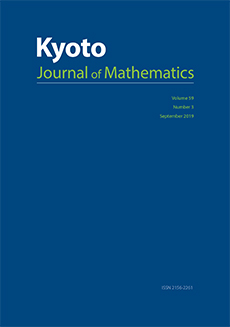Abstract
The Berglund–Hübsch–Krawitz (BHK) mirror symmetry construction applies to certain types of Calabi–Yau varieties that are birational to finite quotients of Fermat varieties. Their definition involves a matrix and a certain finite abelian group , and we denote the corresponding Calabi–Yau variety by . The transpose matrix and the so-called dual group give rise to the BHK mirror variety . In the case of dimension 2, the surface is a K3 surface of BHK type. Let be a K3 surface of BHK type, with BHK mirror . Using work of Shioda, Kelly has shown that the geometric Picard number of may be expressed in terms of a certain subset of the dual group . We simplify this formula significantly to show that depends only upon the degree of the mirror polynomial .
Citation
Christopher Lyons. Bora Olcken. "A simple formula for the Picard number of K3 surfaces of BHK type." Kyoto J. Math. 60 (3) 941 - 964, September 2020. https://doi.org/10.1215/21562261-2019-0051
Information





